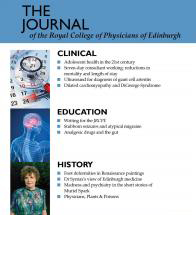There has been a great deal of debate about the introduction of so-called seven-day working in British hospitals. The paper by Leong and colleagues represents an important contribution to the evidence that seven-day working does indeed improve healthcare on medical and care of the elderly wards.
The diagnosis of giant cell (temporal) arteritis can be tricky. Failing to make the diagnosis can result in sight loss and other life-changing problems. Making the diagnosis when the symptoms are due to another condition condemns the patient to many months of inappropriate, initially high dose, corticosteroid therapy. Croft and colleagues present robust evidence that cranial ultrasound has both a high positive and negative predictive value. Cranial ultrasound is widely available and cheap. This paper should change clinical practice.
Last year, the editorial board wrote an editorial What is the JRCPE for?. In this issue we offer practical advice on writing and we hope this will encourage both novice and seasoned authors to contribute to the JRCPE.
In the History section we have an exploration of foot deformities in a selection of Renaissance paintings, an insight into the life of the Edinburgh eccentric ‘Dr Syntax’, and an examination of the short stories of Muriel Spark, where the themes of madness and psychiatry recur throughout.
Finally, this being the last issue of 2015, I’d like to wish all our readers a happy New Year.
Martyn Bracewell
Editor

